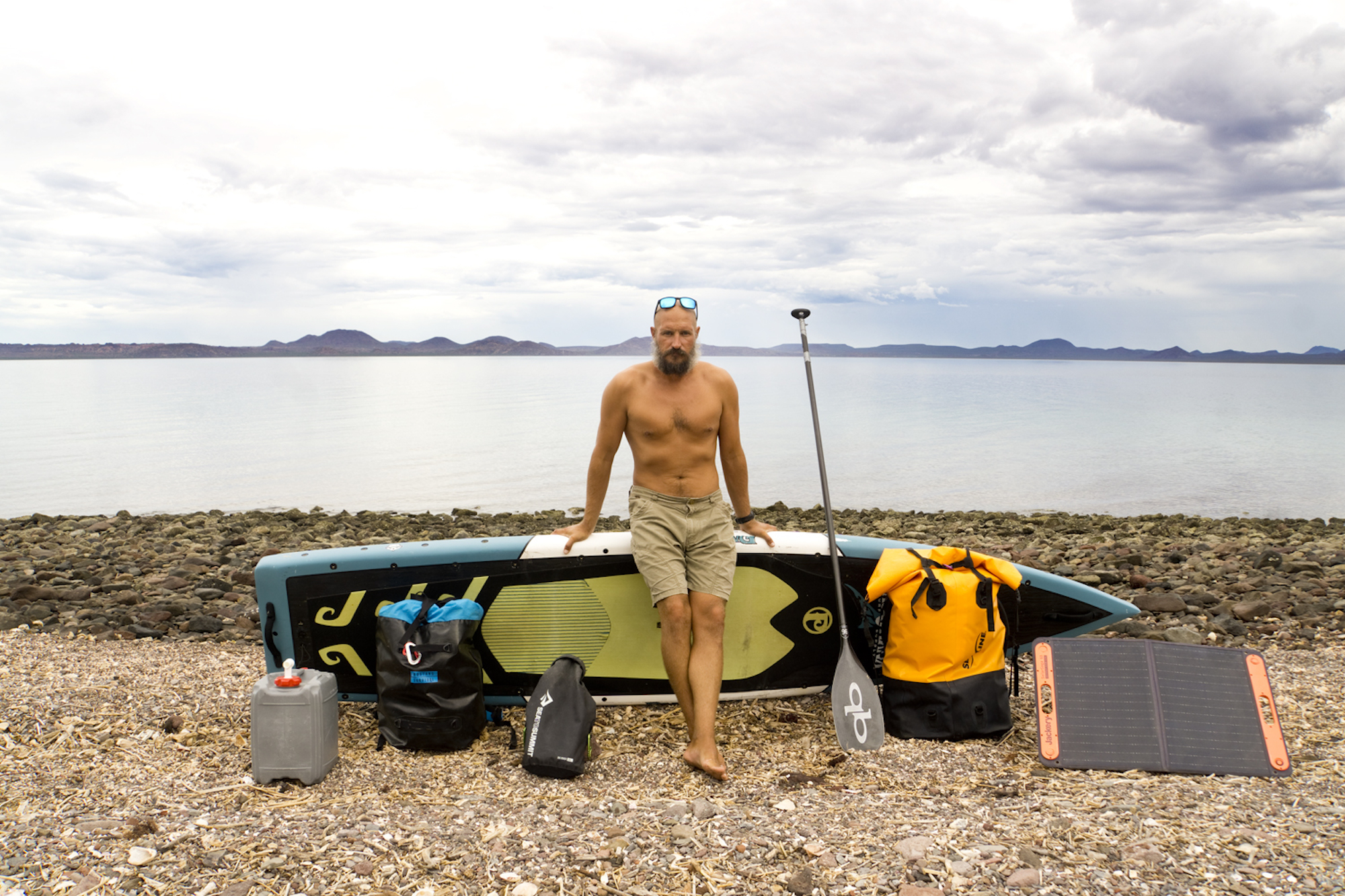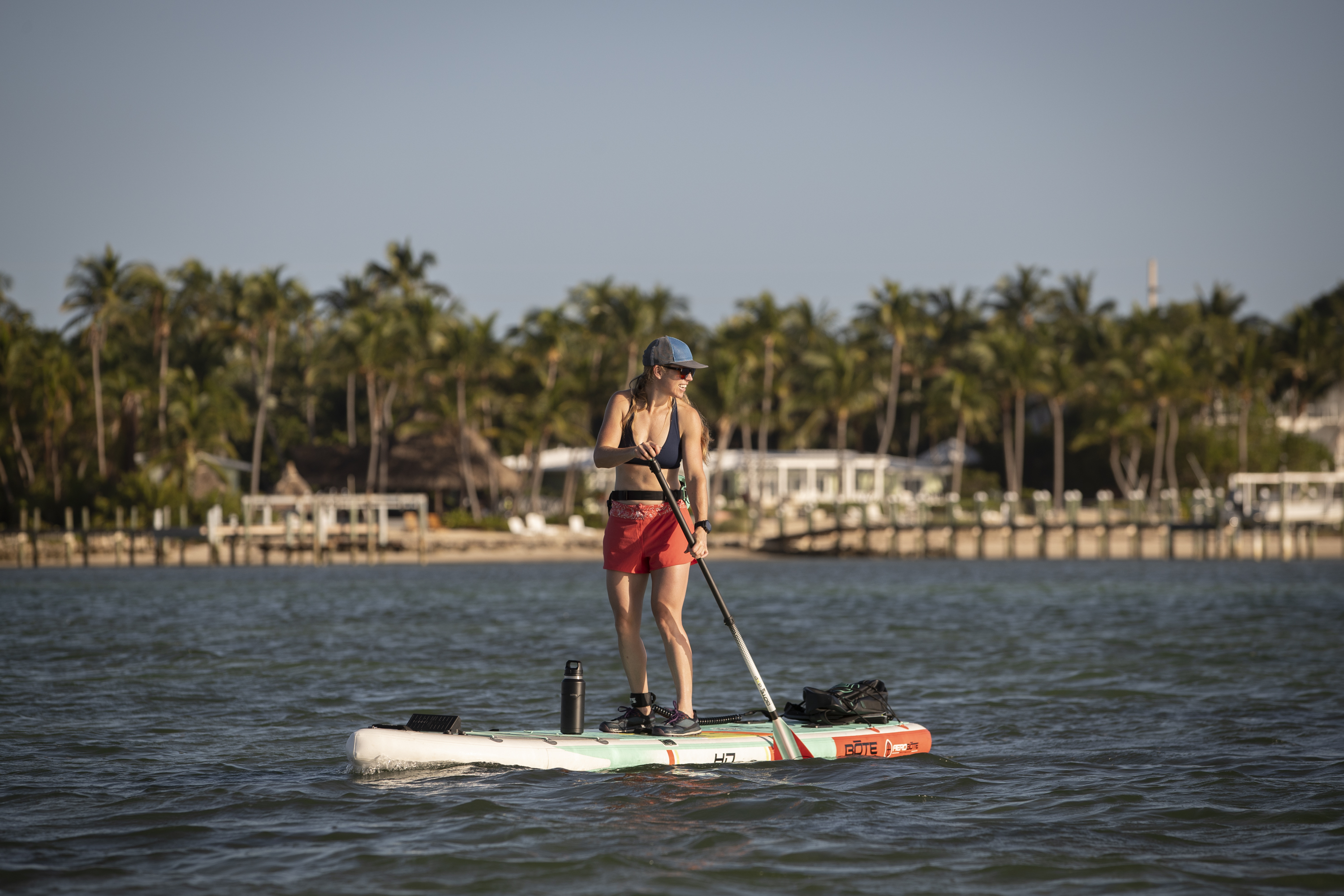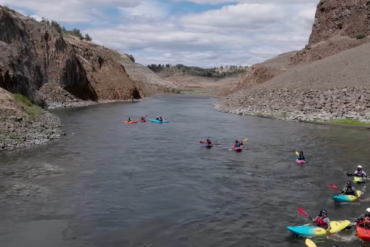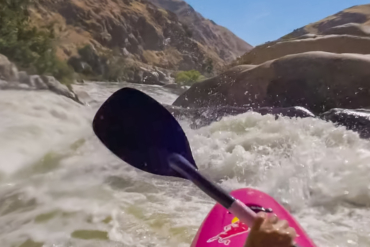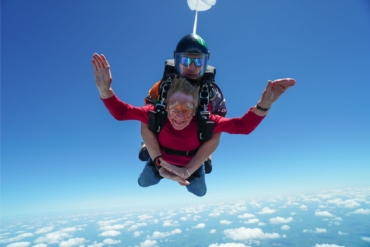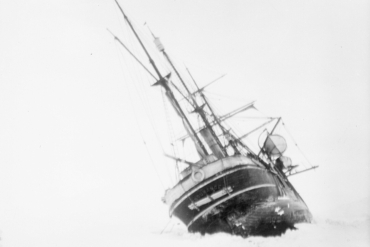I conceptualized my idea nearly 3 years before I actually put a paddle in the water. I had speed bumps, hurdles, tragedies, and personal woes all to overcome before actually setting out on what I thought was going to be a 2-month journey.
Aside from the monumental physical and mental hurdles in place to paddle 1,000 miles on a narrow inflatable, the gear required to do so was also a head-scratcher.
What gear did I use for a 123-day, 1,000-mile journey down Baja’s Sea of Cortez? It took years of planning, years of working, and some generosity to find out what I’d need … and for it to all make its way onto my board.
Here is the list of gear used for anyone out there contemplating the same Baja-bound or similar journey. The gear I used evolved as much as the tides swung and waves broke on the trip, so take what you will from my experience and adapt accordingly.
Standup Paddling Baja’s Sea of Cortez: The Gear I Used
Gear on Deck
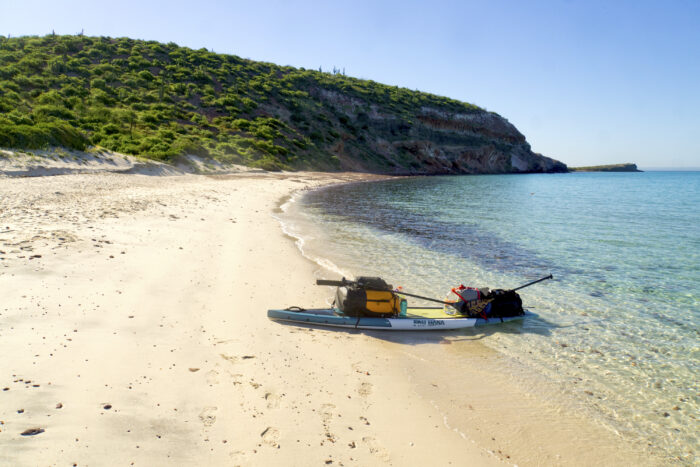
The Paddleboard
I had a relationship with Pau Hana leading up to the trip, but hadn’t talked to them about it. I emailed them, pitching the idea. Crickets. Then with a catcher’s mitt diving to reach the foul ball way out at left field, an email came through and the Endurance XL came into my foresight.
It’s loaded with lashing points where the amount of gear you could tie down is insane. The length worried me at only 12 feet, but the weight-carrying capacity was mind-boggling. At 415 pounds, it would be the perfect ratio of tie-downs and weight stowage to withstand what I was going to put it through.
Design-wise, it also has Ricochet technology that enables it to be dragged up and down the shore with a tough material protecting its bottom. I did puncture holes in the board and repaired accordingly, but this board was without question the unsung hero of the trip. Read my full review of the board.
Straps and Cargo Net

Pau Hana sells separately a cargo net strapping system designed for the Endurance XL and a few other boards. It is a rugged and sturdy cargo net with eight circle metal rings designed to cinch down gear to the deck of the board.
The board itself has 30 threaded attachment points on the deck as well as down the rail of the board, so the gear can be strapped down in front of you while you paddle, as well as behind. I used 10 of these points of contact to keep my gear stowed safely, both in front of me and behind me.
I capsized in rough seas and thought that not only did I lose all my gear, but I was now in a survival situation in the middle of nowhere. But I was able to flip my board back over and saw that not only was all my gear still tied into place, but my cargo barely even shifted from its original position.
I trusted my life with this cargo net strapping system and would do so again.
Gear on My Person (Apparel)
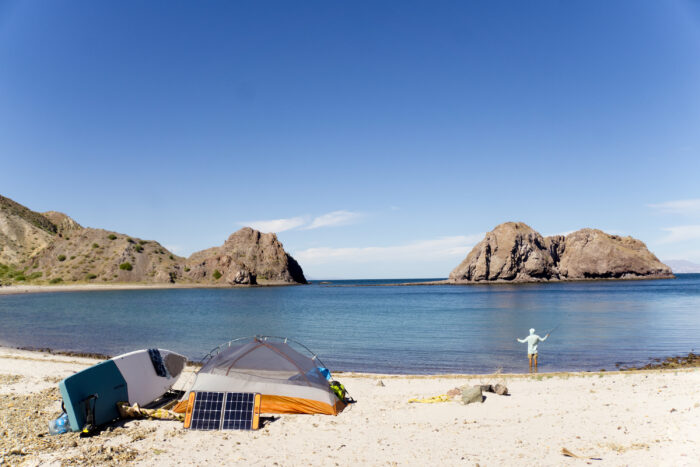
Tops
Sun protection was everything, so I went with Patagonia’s Tropic Comfort Natural UPF Hoody. With natural sun protection and a hood to cover my neck and bald head, this was my daily top.
Bottoms
Again, sun protection was everything, and I never wore shorts while on the water. So I wore REI’s Sahara Cargo Pants. They sadly do not make these anymore, but they were great and not once did I get a sunburn on my body during my paddle.
Shoes
I never paddled barefoot because of the sun, so I needed full-toed shoes. I went with Columbia’s Trailstorm H2O Shoe. It’s a water shoe that has a decent tread for exploring and walking the towns and landscapes. They survived over 1,000 miles of coast, and I have nothing but positive things to say about them.
Gloves
For sun protection and blisters, I went with NRS’s Boater’s Gloves. I didn’t get sunburned but did have blisters. But given the nature of my daily paddling, I’m not sure a single glove in the market could protect against even that.
Sunglasses
I am as irresponsible as it gets when it comes to sunglasses, but given my blue eyes, I needed polarization. Luckily, Goodr makes cheap and epic sunglasses, and they were my go-to for the trip.
Base Layer & Warm Layers
For camping when the nighttime desert temperatures dipped down, I brought a Patagonia R1 base layer top and bottom. I also had Patagonia’s Nanopuff Jacket for those chilly mornings and cooler evenings when the winds blew hard.
Paddle(s)
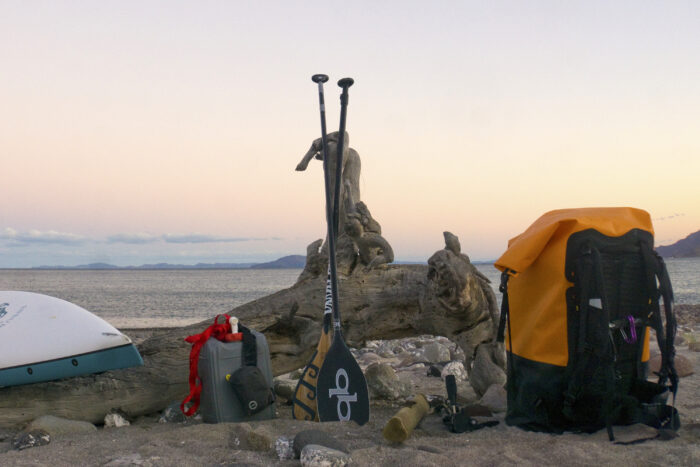
I knew to be able to paddle over 1,000 miles, I was going to need a solid paddle, not these junky and heavy aluminum ones sold at Costco. So I purchased a QuickBlade Trifecta carbon fiber paddle. I doubted its performance for that long, but shouldn’t have. It did just fine and thrived with each stroke while pushing me and all my heavy gear from start to finish.
I did have a backup paddle: Pau Hana’s Endurance SUP Paddle was always strapped to my board in case I needed it.
Dry Bags
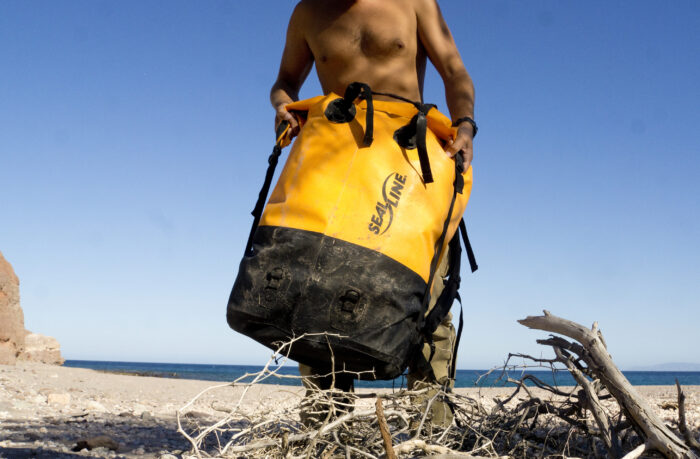
SealLine Pro Dry Pack 120L
I knew what dry bag I wanted for the trip, and SealLine’s 120L Pro Dry Pack was the first of three. I dropped it, dragged it, and slammed it down on cactus, coral, and spiny bushes. There isn’t even a scratch on the material. This dry bag excelled. Look for a full review soon.
Mustang Survival Highwater 60L
I went out on a limb for the remaining two dry packs and trusted fellow coworker and SUP editor at GearJunkie Mary Murphy’s approval on the Mustang Survival Highwater 60L. The Pro Dry Pack was tied to the front of my board whereas the Highwater was tied down in the back. It held all the essential second-hand gear and honestly took the brunt of a lot of the rough water splashed over the deck of the board.
I loved the drawstring and roll-top closures and the amount of grab handles it offered. When it came time to quickly load or unload during rough conditions, this was the bag that I worried about the least. Read my full review for more.
Sea to Summit Big River 13L
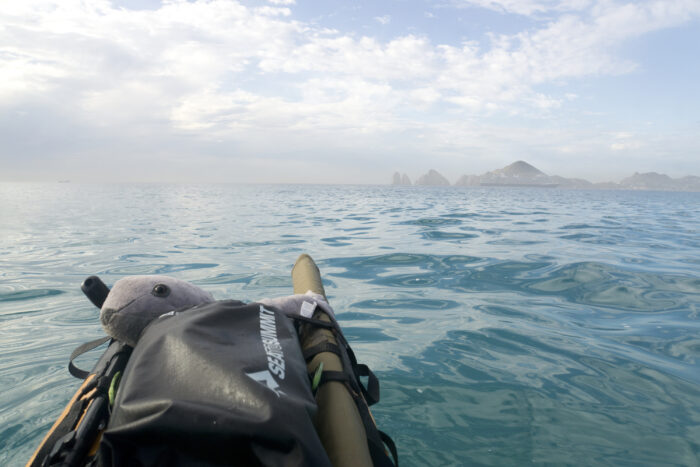
The final dry bag I used was Sea to Summit’s Big River. I used the 13L to strap down on top of the SealLine Pro Dry Pack which held all of my important items: passport, wallet, drone, camera, etc. I loved the roll-top design and the sturdy material. It also has side straps that were perfect to keep tied down to anything. I trusted this bag the most out of all three, and it reminded me each day that everything was (more or less) fine.
Water
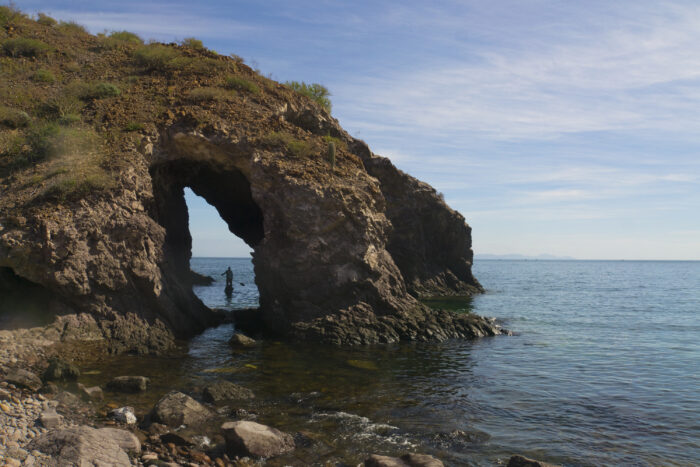
More people have paddled the Inside Passage up along the British Columbia and Alaska coast than they have Baja’s Sea of Cortez. And a huge arguing point for that is water. There isn’t a single freshwater stream that naturally flows into the sea along the coast. So you’ll either have to bring water with you or find a way to turn salt water into fresh. I did both.
Reliance Outdoor Jugs
I carried with me a minimum of 5 gallons of fresh water for each section of my trip. In between I planned out towns and/or fish camps where I could potentially buy or barter for water. I used Reliance Outdoor’s Aqua-Stack 5-gallon jug for the bulk of my water carrying.
It’s relatively low in height compared to the others on the market, and I could easily tie it to the deck of my board. But in 90-100-degree heat, these precious 5 gallons would last 3 days, tops. So I had to improvise.
MSR Dromedary
I also was loaned a Dromedary Bag from a friend halfway down the peninsula. MSR’s 10L Dromedary Bag accompanied me for the remainder of the trip.
Nalgene
I carried with me a classic 1L Nalgene water bottle. It’s lightweight, and the plastic lid loop was perfect for me to connect to my dry pack.
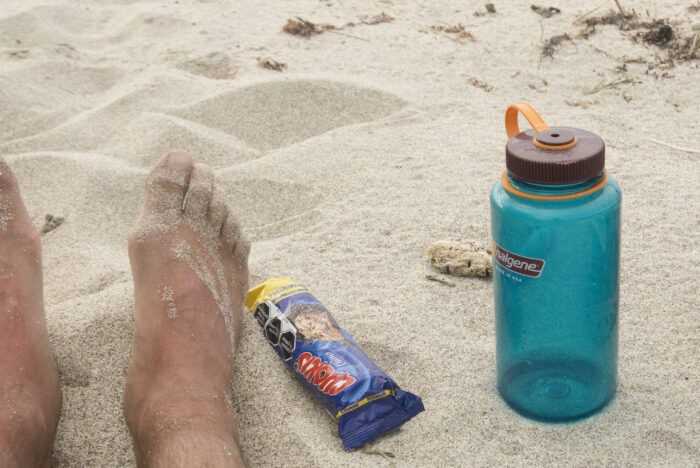
Katadyn Survivor 35
Now, the final piece of my water puzzle was my Reverse Osmosis hand pump. I wasn’t even going to consider this trip without one. I searched high and low to find a somewhat portable hand pump that I could turn saltwater into fresh and ran into dead end after dead end. Until I came across Katadyn’s Survivor 35.
These are not sold at REI. I found one on a military surplus store’s website and made the excruciating purchase. It’s heavy, bulky, expensive, and slow. But it saved my life a few times on the trip.
It pumps about 1 L of fresh water in a half hour. So, it isn’t efficient and isn’t something I wanted to rely on. But I’m grateful for it.
Camping Gear
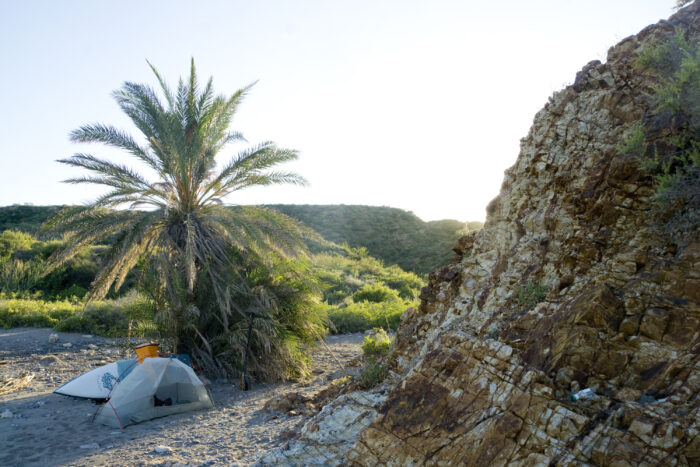
Tent
I went with the Big Agnes Copper Spur HV UL1. Super lightweight and packs away very small so I can save room for the rest of the heavy and bulky gear.
Sleeping Bag
After I finished the Pacific Crest Trail in 2015, I was working side by side with Rab and Lowe Alpine. They gifted me their 15-degree Neutrino Pro Down Sleeping Bag. This bag was beyond overkill, as most nights I would sleep on top of it for how hot it was.
Sleeping Pad
I have popped so many air pads on the market that I have completely lost interest at all in them. I also didn’t want to spend energy pumping up a pad after a super-long and hard day on the water. So I stayed with the Therm-a-Rest Z Pad.
Gear for Cooking
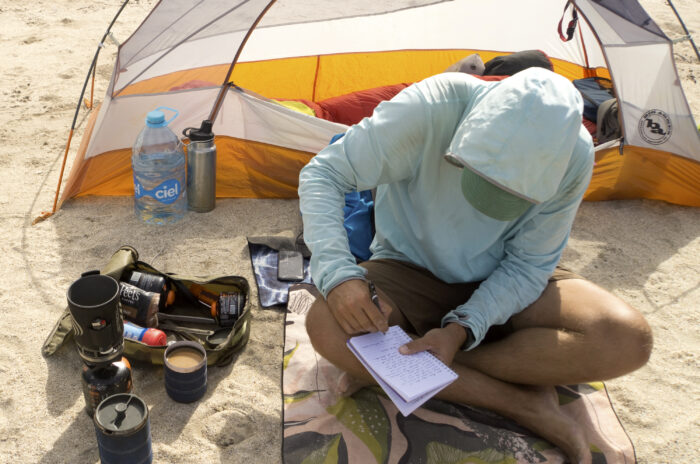
Stove
The Jetboil Zip goes everywhere with me. It’s fast and efficient and stows away perfectly. It also comes with a French press adapter for coffee, which has changed my backcountry game since 2015. Long are the days of instant coffee.
Utensils
Always with me comes the Sea to Summit Alpha Light Long Spork. It was perfect for reaching deep into those last few grinds of coffee and the remaining refried beans in the bag.
I also brought with me my Swiss Army knife. It comes with me on every trip, and was great for flicking away spiders and scorpions out of camp.
Electronics and Accessories
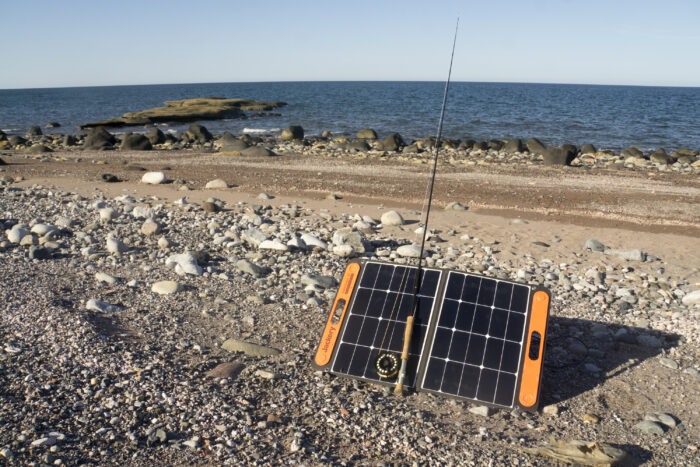
Solar
Given the nature of my work and needing to document, I needed a serious charging game. Luckily, Baja’s desert and weather could help me in this regard and I went with the Jackery Solar Saga 60 panel. It’s the smallest in the brand’s line and is the most affordable. And because of its water resistance, I went with it in case my dry bag sprung a leak.
Power Bank(s)
With the solar, I brought the Jackery Explorer 160 Portable Power Station. This may have been overkill to bring in conjunction with the solar panel, but given the nature of everything I had to charge, it was awesome to have.
GPS & Watch
I used the Garmin inReach Mini2. It has an epic battery life, and I bought the expedition plan so I could send as many messages as I wanted each month as well as get a daily weather forecast. I also wore the Suunto 5 GPS watch. It was great as it tracked my mileage and calories burned.
Headlamp
I went with Petzl’s Actik Core for its USB rechargeable capabilities. Its battery life is insane, and it accompanied me well during my early morning paddles.
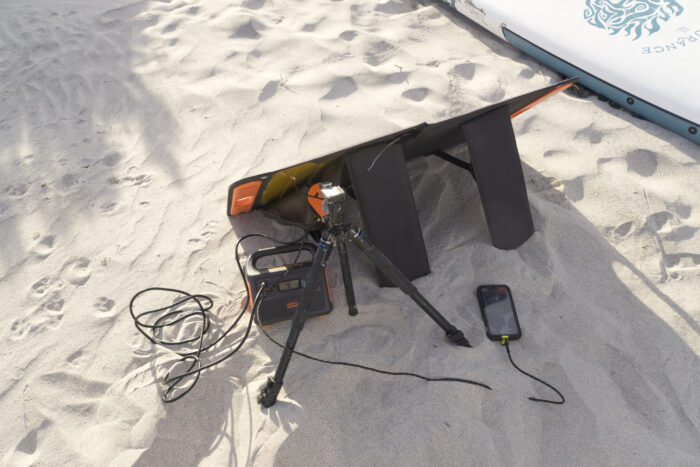
Camera
I have not updated my camera in years, but I used my Sony Mirrorless A6000 with a Tamron 18-200 lens. This setup worked great for my needs and was USB rechargeable.
Sore subject, but I bought the GoPro11 for the trip and ended up dropping it into the water, never to be seen again. But loved it when I had it! A GoPro still deserves a spot on this gear list.
Drone
I didn’t want to use or buy a drone on the trip ,as I was solo and shooting self-shot images of myself while I paddled seemed not just annoying, but nearly impossible. But I was convinced and bought the DJI Mini 2. And I will say, the shots I was able to get when the conditions allowed made it worth it. And I could USB recharge.
Fan
Given how hot the nights were, a small fan made it possible to sleep. I went with a Target-bought, Holmes USB-rechargeable fan. It seems like an odd and bulky thing to bring, but it saved me a few times.
Food

Aside from water, food was always the next big question. And given the conservancy of my fresh water, I couldn’t really cook or make meal kits like most of us do in the backcountry. Most of my meals were just cold tortillas and bean and cheese burritos. I would pack out chips or tostadas to mix it up, but sadly, almost every meal was cold burritos.
If I was able to stop in a town, I would pack out city-made tacos or tortas or bring some meat cooked in foil. I thrived on peanut butter and Ritz Crackers. Sandwiches too, and I ate more bars than I knew what to do with.
Miscellaneous Gear
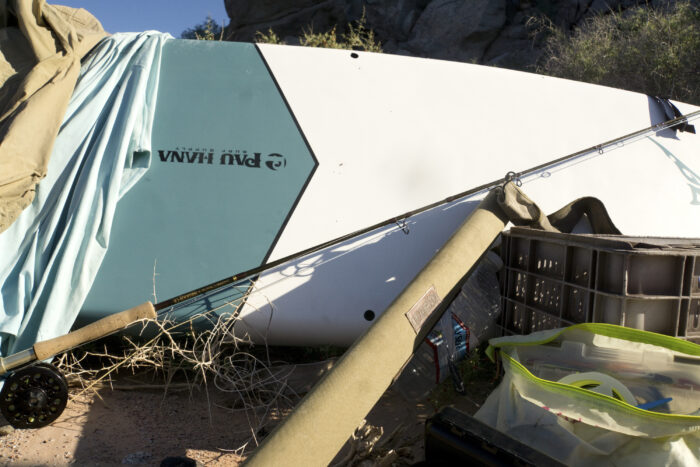
Fly Rod
I brought a ten-weight fly rod and flies with hopes of catching a roosterfish. But sadly, that never happened. But I did get into a handful of other species that made it all worth it.
Tripod
For a lot of my self-timed shots, I needed a tripod. I brought with me a Slik tripod and it worked great…until the saltwater nearly corroded it shut.
Conclusion

This trip gave me nightmares. The winds would haunt me at night, drove me to wake early and paddle before the sun got too hot, as well as enticed me in with each white sand beach with crystal clear water.
I learned to be present and accept that Mother Nature wasn’t for me or against me; she just is what she is.
I don’t really have a pinpoint as to why I chose to attempt this trip, much less on a SUP. Given the nature of the amount of gear as well as the pain of having to deal with the weight and worry of fresh water in a desert, it’s safe to say why I know no one, to my knowledge, has attempted to paddle this coast on a SUP.
Now since completing the trip, I would consider leaving a few things home. But at the same time, each played a role in helping me down the coast. I am thrilled at the opportunity to keep pushing the boundary of expedition SUP trips. I hope this one, along with all the gear, will help guide adventures of your own.
